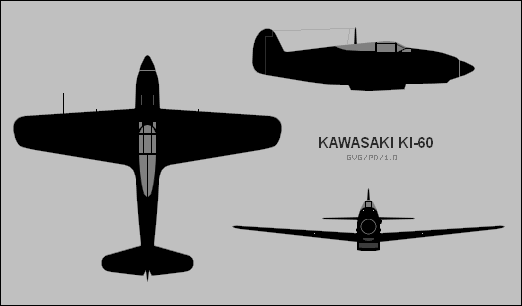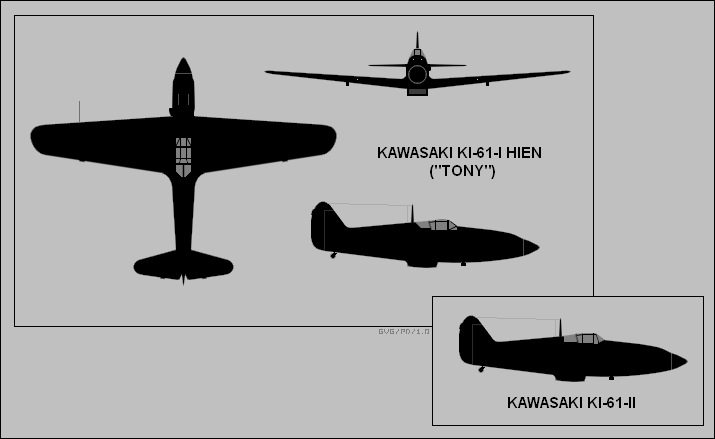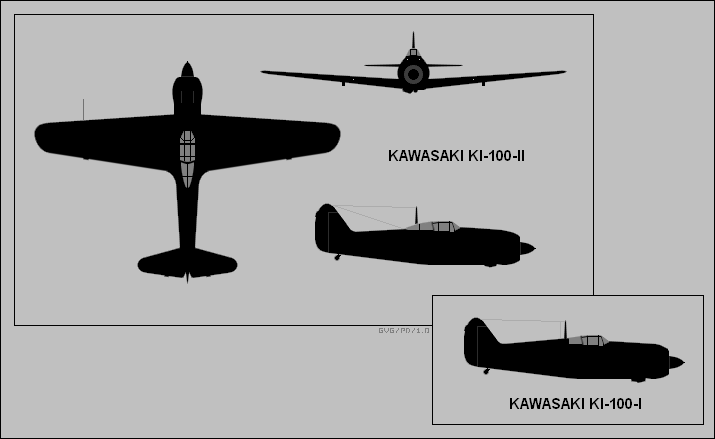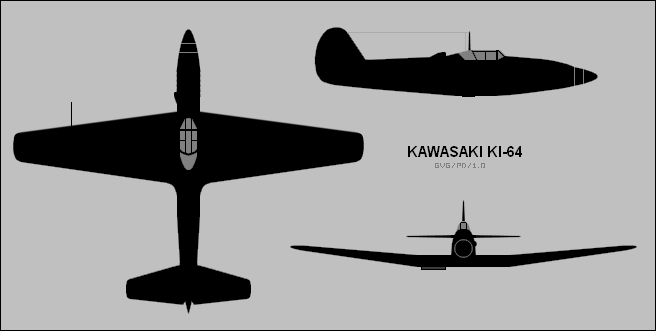
This book is available from AMAZON.COM!

v1.2.0 / 01 jul 03 / greg goebel / public domain
* The Kawasaki Ki-61 Hien ("Swallow") fighter represented a major departure for Japanese aircraft design in World War II. While other Japanese fighters were designed with air-cooled radials and were optimized for maneuverability, the Ki-61 used a liquid-cooled in-line engine and was designed for speed and power.
In fact, the Ki-61 was so different from other Japanese fighters that when the type was first encountered in combat over New Guinea in June 1943, the Allies thought it wasn't a Japanese design at all. At first they believed it was a copy of the German Messerschmitt Me-109, then suspected it was a copy of the Italian Macchi C.202 Foglore or similar Italian fighter. For this reason they gave it the code-name "Antonio", or "Tony", though by the summer of 1943 the Allies had realized the Ki-61 was in fact a Japanese design.
The Hien proved initially successful in combat against American fighters. As the war in the Pacific ground on, however, the Ki-61 found itself increasingly outclassed, but it soldiered on until the end of hostilities. This document describes the history of the Ki-61 and its radial-engine derivative, the Ki-100.

* The confusion of the Ki-61 with German and Italian fighters had some basis in the aircraft's origins. Between 1923 and 1933, Kawasaki Aircraft Engineering Company's head designer was a German named Dr. Richard Vogt, who returned to Germany in 1933 to take a similar position at the firm of Blohm und Voss during the war. Not surprisingly, Kawasaki continued to be strongly influenced by Dr. Vogt's beliefs after he left, particularly a faith in the usefulness of liquid-cooled inline engines. This made Kawasaki something of a heretic among Japanese aircraft manufacturers, who preferred air-cooled radials.
In March 1938, Kawasaki signed an agreement with Daimler-Benz of Germany for manufacturing rights to the liquid-cooled inline engines then under development by the German firm. In April 1940, a Kawasaki engineering team visited Daimler-Benz in Stuttgart to obtain plans and samples of the DB-601A engine, then being used in the Me-109.
The Kawasaki engine team managed to increase the take-off power of their version of the engine to 875 kW (1,175 HP) and reduce its weight slightly. The engine was put into production in November 1941. It was designated the "Ha-40", or "Army Type 2", though it would be later redesignated the "Ha-60" in a combined Army/Navy nomenclature.
In the meantime, certain officers at the Air Headquarters of the Imperial Japanese Army were very interested in the new fighters powered by liquid-cooled being developed in Britain, the USA, the USSR, Germany, and France. The Japanese Army also had unpleasant experiences in air combat against the Soviet Polikarpov I-16 fighter during the beating the Imperial Army took in their Manchurian border clash with the USSR in the summer of 1939. This experience suggested the the single-minded focus on agility above all that characterized Japanese fighter design doctrine might need to yield to a focus on speed and improved armor protection and firepower.
* In February 1940, the Army initiated work with Kawasaki on two single-seat fighters based on the DB-601 derivative engine: a heavy interceptor, designated the "Ki-60", and a general-purpose fighter, designated the "Ki-61". Kawasaki decided to build the Ki-60 first, and the design team, under Kawasaki chief designer Takeo Doi and his deputy Shin Owada, constructed three prototypes of the interceptor in 1941.

The Ha-40 engine was not available at that time, so the three aircraft were
powered by sample DB-601A engines obtained from Germany. The Ki-60 was a
low-wing monoplane, with plenty of power and heavy armament by Japanese
standards. The first and second prototypes had two 12.7 millimeter (0.50
caliber) Ho-103 machine guns mounted on the nose in front of the pilot and
two 20 millimeter Mauser MG-151 cannons, one mounted in each wing, for a
total of four guns. The third prototype had four 12.7 millimeter guns.
KAWASAKI KI-60:
_____________________ _________________ _______________________
spec metric english
_____________________ _________________ _______________________
wingspan 10.5 meters 34 feet 5 inches
wing area 16.2 sq_meters 174.4 sq_feet
length 8.47 meters 27 feet 9 inches
height 3.7 meters 12 feet 2 inches
empty weight 2,150 kilograms 4,740 pounds
loaded weight 2,750 kilograms 6,063 pounds
max speed at altitude 560 KPH 348 MPH / 303 KT
service ceiling 10,000 meters 32,800 feet
_____________________ _________________ _______________________
* The experience was valuable, however. Design work on the Ki-61, whose development had been proceeding in parallel with the Ki-60 since December 1940, incorporated new features derived from the lessons learned by the Ki-60 program:
The first prototype was rolled out in early December 1941, and its performance proved excellent. Eleven more prototypes were delivered to the Army, which performed intensive trials with them. The Ki-61 was pitted against other Japanese fighters, as well as against the Messerschmitt Bf-109E-3, of which two had been bought by the Army from the Germans, and the Curtiss P-40E, several of which had been captured during the seizure of the Dutch East Indies.
While the test pilots were a little skeptical of the new aircraft at first, pilots with combat experience appreciated the Ki-61's self-sealing fuel tanks, heavier armor and armament, and fast diving speed. The air combat tests showed the Ki-61 to be faster than all its adversaries in the tests, and easily out-maneuvered all of them except the Japanese Nakajima Ki-43 ("Oscar").
The 13th Ki-61, a production prototype, was delivered in August 1942. The Army gave the green light for production, and the fighter began to roll off the assembly line, with 34 delivered by the end of 1942. The type was formally known as the "Army Type 3 Fighter Model 1 Hien", or "Ki-61-I".
The production machines differed from the prototypes only in tweaky details. Initial production consisted of two variants: the "Ki-61-Ia", with two 12.7 millimeter guns in the nose and a 7.7 millimeter gun in each wings for a total of four guns; and the "Ki-61-Ib", with 12.7 millimeter guns in both fuselage and wings. These aircraft could be fitted with two 200 liter (53 US gallon) drop tanks.
* The Hien entered combat in the spring of 1943 in the New Guinea war zone, covering New Guinea, the Admiralty Islands, New Britain, and New Ireland. The new Japanese fighter caused some pain and consternation among Allied pilots, particularly when they found out the hard way that they could no longer go into a dive and escape as they had from lighter Japanese fighters. 5th Air Force Commander General George Kenney found his P-40 Warhawks completely outclassed, and begged for more P-38 Lightnings to counter the threat of the new enemy fighter.
The Ki-61 demonstrated only a few teething problems in field use, such as a tendency towards engine overheating during ground running under tropical conditions. However, despite the heavier armament, it still didn't have the punch to easily knock rugged and well-armed Allied bombers out of the sky.
The Kawasaki designers had forseen this problem. The Japanese Ho-5 20 millimeter cannon wasn't available at the time, but the Japanese obtained 800 Mauser MG-151/20 20 millimeter cannon from Germany in August 1943, and modified 388 Ki-61-I airframes on the production line to carry the German weapons in place of the two 12.7 millimeter wing guns. The cannon had to be mounted on their sides to fit into a wing, with an underwing blister for the breech, and some reinforcements were added to the wing to absorb the increased recoil.
* Once the Ho-5 cannon became available, Kawasaki designers then reversed the arrangement of the guns, putting the 20 millimeter cannon in the nose and the 12.7 millimeter guns in the wings. While they were making these modifications, they also made a few changes to streamline manufacturing and simplify field maintenance.

This new variant was designated the "Ki-61-I KAIc" (where "KAI" was for
"kaizo", or "modified") was 19 centimeters (7.5 inches) longer than its
predecessors, with a detachable rear section, a fixed tailwheel instead of
the retractable tailwheel previously used, stronger wings, and stores pylons
outboard of the main landing gear, allowing it to carry two 250 kilogram (550
pound) bombs.
KAWASAKI KI-61-I KAIC:
_____________________ _________________ _______________________
spec metric english
_____________________ _________________ _______________________
wingspan 12 meters 39 feet 4 inches
wing area 20 sq_meters 215.3 sq_feet
length 8.94 meters 29 feet 3 inches
height 3.70 meters 12 feet 2 inches
empty weight 2,630 kilograms 5,800 pounds
loaded weight 3,470 kilograms 7,650 pounds
maximum speed 590 KPH 366 MPH / 318 KT
service ceiling 10,000 meters 32,810 feet
range 1,800 kilometers 1,120 MI / 975 NMI
_____________________ _________________ _______________________
Total production of all subvariants of the Ki-61-I was 2,654, with the Ki-61-I KAIc accounting for over half that number.
* Even before the Hien saw combat, the Army had been pressing Kawasaki for an improved version of the same aircraft. To this end, Kawasaki engineers focused on an improved version of the Ha-40 engine known as the "Ha-140", which was expected to have a take-off power of 1,120 kW (1,500 HP).
The first prototype of the new variant, the "Ki-61-II", flew in August 1943. Ten more prototypes were ordered. They featured a wing with 10% more area, and an improved canopy to provide better rear visibility, but the Ha-140 development program ran into troubles, and only eight of the prototypes received engines. Even then, they suffered from engine troubles, structural failures due to weaknesses in the new wing, and handling problems.
In an attempt to fix the problems, after delivery of the eighth Ki-61-II prototype, the ninth prototype was extensively modified during manufacture. The extended wing was replaced with the original Hien wing, the fuselage was lengthened, and the rudder area increased. The result was the "Ki-61-II KAI", with initial flight of the prototype in April 1944. It was followed by 30 more prototypes. As long as the temperamental Ha-140 engine worked properly, the Ki-61-II KAI proved to be a promising interceptor, with a fast climb rate and good high-altitude flight characteristics.
Despite the problems with the engine, the military situation was increasingly desperate, and so the Ki-61-II KAI was put into production anyway in September 1944. Two versions were produced, one designated "Ki-61-II KAIa", with 12.7 millimeter guns in the wings and 20 millimeter cannon in the nose, and the other designated "Ki-61-II KAIb", with four 20 millimeter cannon.
374 Ki-61-II KAI airframes were built and 99 of them fitted with engines. Then, on 19 January 1945, US Army Air Force B-29 Superfortresses turned the plant at Akashi that was building the Ha-140 engine into cinders and rubble. That abruptly ended concerns over the reliability of the Ha-140 engine, but left 275 airframes sitting around without powerplants.
* However, in November 1944 concerns over the availability (or lack thereof) of the Ha-140 engine had led the Munitions Ministry to request that Kawasaki redesign the Ki-61-II KAI to use an available engine. Company engineers performed a lightning design effort to mate the fighter to the 1,120 kW (1,500 HP) Mitsubishi Ha-112-II 14-cylinder double-row air-cooled radial engine. The engineers inspected the radial engine installation of a sample Focke-Wulf FW-190 fighter obtained from Germany and, in an example of interservice cooperation that was far more the exception than the rule between the Imperial Japanese Army and Navy, took advantage of Navy efforts to use the Ha-112-II.
The first prototype conversion of three took to the air on 1 February 1945. Sometimes improvisations work poorly, sometimes they work surprisingly well, and the new variant demonstrated excellent performance. The rest of the engineless Ki-61-II KAI airframes were then converted to the new fighter type, which was designated the "Ki-100-Ia". They retained the armament of the Ki-61-II KAIb, consisting of 12.7 millimeter guns in the wings and 20 millimeter guns in the fuselage.
Performance was roughly the same but engine reliability was vastly improved. The Ki-100 was in fact an excellent fighter, a nasty customer for Allied aircraft to deal with while being surprisingly comfortable and easy to fly, an important consideration when experienced Japanese pilots were in increasingly short supply.

A batch of 118 new-production Ki-100s were then built, incorporating an all-round vision canopy, tested on a modified Ki-61-II KAI, and given the designation "Ki-100-Ib".
Work was then done to add a turbosupercharger and water-methanol engine boost
to the Ki-100 to provide improved high-altitude performance. The first
prototype of this variant, designated the "Ki-100-II", flew in May 1945, with
two more prototypes completed before Japan's surrender ended plans for
production.
KAWASAKI KI-100-IB:
_____________________ _________________ _______________________
spec metric english
_____________________ _________________ _______________________
wingspan 12 meters 39 feet 4 inches
wing area 20 sq_meters 215.3 sq_feet
length 8.82 meters 28 feet 11 inches
height 3.75 meters 12 feet 4 inches
empty weight 2,525 kilograms 5,567 pounds
loaded weight 3,495 kilograms 7,705 pounds
max speed at altitude 580 KPH 360 MPH / 315 KT
service ceiling 11,000 meters 36,000 feet
normal range 1,400 kilometers 870 MI / 755 NMI
_____________________ _________________ _______________________
The home defense units operating on Japan used a mixed bag of Ki-61 variants, essentially anything they could get their hands on. The most famous of these units was the 244th Sentai (Fighter Group) under Japanese ace Major Tembico Kobayashi. Major Kobayashi encouraged his men to perform frontal attacks on B-29s and press their assaults to close range, even ramming if that was what was needed. Major Kobayashi set an example by fighting with almost suicidal determination.
By this time, the Hien was outclassed by American Mustangs and other late-model US fighters. In fact, when attacking B-29s Hiens often had to be protected by Ki-100s. Operations dwindled as planes and pilots continued to fall in combat and fuel and spare parts dried up. By the end, the home defense units were no longer capable of posing a real threat to the Americans.
Of the 3,159 Hiens built, not many survived the war. Several were evaluated by the Americans and one was presented back to Japan by the US Air Force later. This was the only surviving Hien as of the mid-1960s. American aircraft restorer Kermit Weeks has a Ki-61 airframe in slow process of restoration.
* The Ki-61 wasn't the only fighter design to be powered by the Ha-40 engine. Kawasaki also experimented with an unusual twin-engine design conceived by Takeo Doi in 1939 and approved for prototype development in October 1940 as the Kawasaki "Ki-64".

The Ki-64 actually had both engines in a line, straddling the cockpit and
driving a single contra-rotating prop system with twin three-bladed props.
The combined engine was known as the "Ha-201", and generated 1,755 kW (2,350
HP) take-off power. It featured an unusual steam cooling system with
radiators in the wing and flap surfaces. The front engine used the right
wing for cooling, while the rear engine used the left wing. The Ki-64 had a
vague configurational resemblance to the Hien, though it was larger.
KAWASAKI KI-64 (ESTIMATED SPECIFICATIONS):
_____________________ _________________ _______________________
spec metric english
_____________________ _________________ _______________________
wingspan 13.5 meters 44 feet 4 inches
wing area 28 sq_meters 301.4 sq_feet
length 11.03 meters 36 feet 2 inches
height 4.25 meters 13 feet 11 inches
empty weight 4,050 kilograms 8,929 pounds
loaded weight 5,100 kilograms 11,245 pounds
max speed at altitude 690 KPH 429 MPH / 375 KT
service ceiling 12,000 meters 39,400 feet
range 1,000 kilometers 620 MI / 540 NMI
_____________________ _________________ _______________________
* I seem to be strongly inclined in my writing to describe aircraft I made models of when I was a kid. This is something of an attempt at vindication, I think, because I was such an inept modelmaker. However, I do recall that I did a fair-to-middling job on my 1/72 scale Ki-61, and it still sticks in my mind, though the sleek "sky shark" look of the Hien helped make it memorable as well.
One of the puzzles in writing about Japanese aircraft is trying to figure out whether to use the Japanese name ("Hien") or the Allied codename ("Tony") in the text. Obviously one of the reasons for giving codenames was to give Allied forces a more easily recognized "handle" for the aircraft than the Japanese designation, if the Allies even knew what the Japanese designation was when a new aircraft appeared.
Using the Allied codename might be a bit more convenient, but somehow giving an aircraft a name assigned by an enemy seems disrespectful. The Hien is the hero of its own story and even if it was used against my own countrymen, it deserves to be respected on its own terms.
* Sources include:
* Revision history:
v1.0 / 28 feb 97 / gvg
v1.1 / 01 aug 99 / gvg / Minor cosmetic update.
v1.2.0 / 01 jul 03 / gvg / General cleanup and update.